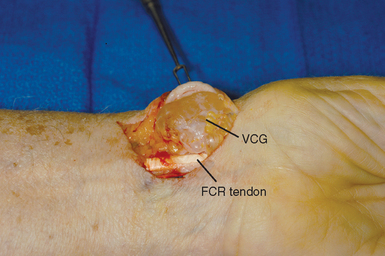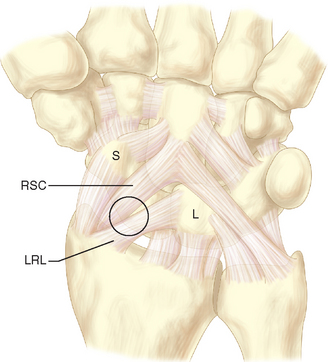CHAPTER 22 Arthroscopic Treatment of Volar Carpal Ganglion Cysts
“Other things may change us, but we start and end with family”
To Nancy, Ryann, and Sawyer, who support and put up with me, constantly.
Arthroscopic Resection of Volar Carpal Ganglia
The concept of using arthroscopy as a means for the management of intra-articular conditions of the wrist has evolved tremendously since Roth first described the technique.1 Arthroscopy of the wrist has become an essential adjunctive tool not only for the diagnosis of multiple conditions but for their definitive treatment. Intra-articular lesions, including capsular lesions, can be assessed and treated arthroscopically.
In 1995, Osterman and Raphael presented a technique for the treatment of the dorsal carpal ganglion.2 This cystic structure has a predictable origin from the dorsal distal third of the scapholunate ligament. The initial skepticism regarding treatment of this lesion (which is at the anatomical boundary for visualization with the arthroscope) has been quelled by experience and refinement of the technique. Arthroscopic treatment of dorsal ganglion cysts is now routine for the experienced arthroscopist.3–5
Volar ganglia occur less frequently than the more common dorsal carpal ganglion cyst, accounting for approximately 20% of wrist ganglia. They are sac-like structures (with no true cellular lining) filled with a thick viscous fluid consisting of glucosamine, albumen, globulin, and hyaluronic acid. The ganglion frequently presents externally as a mass in the interval between the flexor carpi radialis (FCR) tendon and radial artery, proximal to the wrist flexion crease (Figure 22.1). Usually, the ganglion presents as a visible and palpable mass—with symptoms that may include pain, numbness secondary to irritation of the palmar cutaneous branch of the median nerve (PcuBrMN), and cosmetic dissatisfaction.
Occult volar ganglia may also contribute to volar wrist pain without a visible or definitely palpable mass. These occult ganglia may be symptomatic due to capsular injury, inflammatory changes, or local pressure. The cause of ganglion cysts has been debated and has been attributed to synovial herniation, mucoid degeneration, degenerative arthritis, and stretch associated with trauma.6,7
The anatomical origin of the volar carpal ganglion (VCG) has not been as well defined as its dorsal counterpart. Current literature supports a radioscaphoid or scaphotrapezial joint origin.7,8 They may occasionally originate from the FCR tendon or from aberrant locations.6,9 When the ganglion originates from the radioscaphoid joint, it arises from the volar capsule in the relatively deficient area between the volar radioscaphocapitate (RSC) and long radiolunate (LRL) ligaments (Figure 22.2).10
< div class='tao-gold-member'>
Stay updated, free articles. Join our Telegram channel

Full access? Get Clinical Tree










